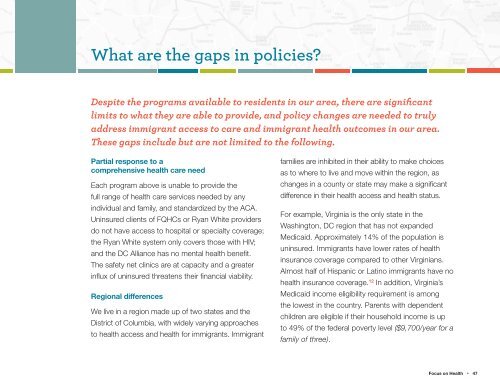Immigration Status
pCFC307gQoX
pCFC307gQoX
Create successful ePaper yourself
Turn your PDF publications into a flip-book with our unique Google optimized e-Paper software.
What are the gaps in policies?<br />
Despite the programs available to residents in our area, there are significant<br />
limits to what they are able to provide, and policy changes are needed to truly<br />
address immigrant access to care and immigrant health outcomes in our area.<br />
These gaps include but are not limited to the following.<br />
Partial response to a<br />
comprehensive health care need<br />
Each program above is unable to provide the<br />
full range of health care services needed by any<br />
individual and family, and standardized by the ACA.<br />
Uninsured clients of FQHCs or Ryan White providers<br />
do not have access to hospital or specialty coverage;<br />
the Ryan White system only covers those with HIV;<br />
and the DC Alliance has no mental health benefit.<br />
The safety net clinics are at capacity and a greater<br />
influx of uninsured threatens their financial viability.<br />
Regional differences<br />
We live in a region made up of two states and the<br />
District of Columbia, with widely varying approaches<br />
to health access and health for immigrants. Immigrant<br />
families are inhibited in their ability to make choices<br />
as to where to live and move within the region, as<br />
changes in a county or state may make a significant<br />
difference in their health access and health status.<br />
For example, Virginia is the only state in the<br />
Washington, DC region that has not expanded<br />
Medicaid. Approximately 14% of the population is<br />
uninsured. Immigrants have lower rates of health<br />
insurance coverage compared to other Virginians.<br />
Almost half of Hispanic or Latino immigrants have no<br />
health insurance coverage. 12 In addition, Virginia’s<br />
Medicaid income eligibility requirement is among<br />
the lowest in the country. Parents with dependent<br />
children are eligible if their household income is up<br />
to 49% of the federal poverty level ($9,700/year for a<br />
family of three).<br />
Focus on Health • 47


